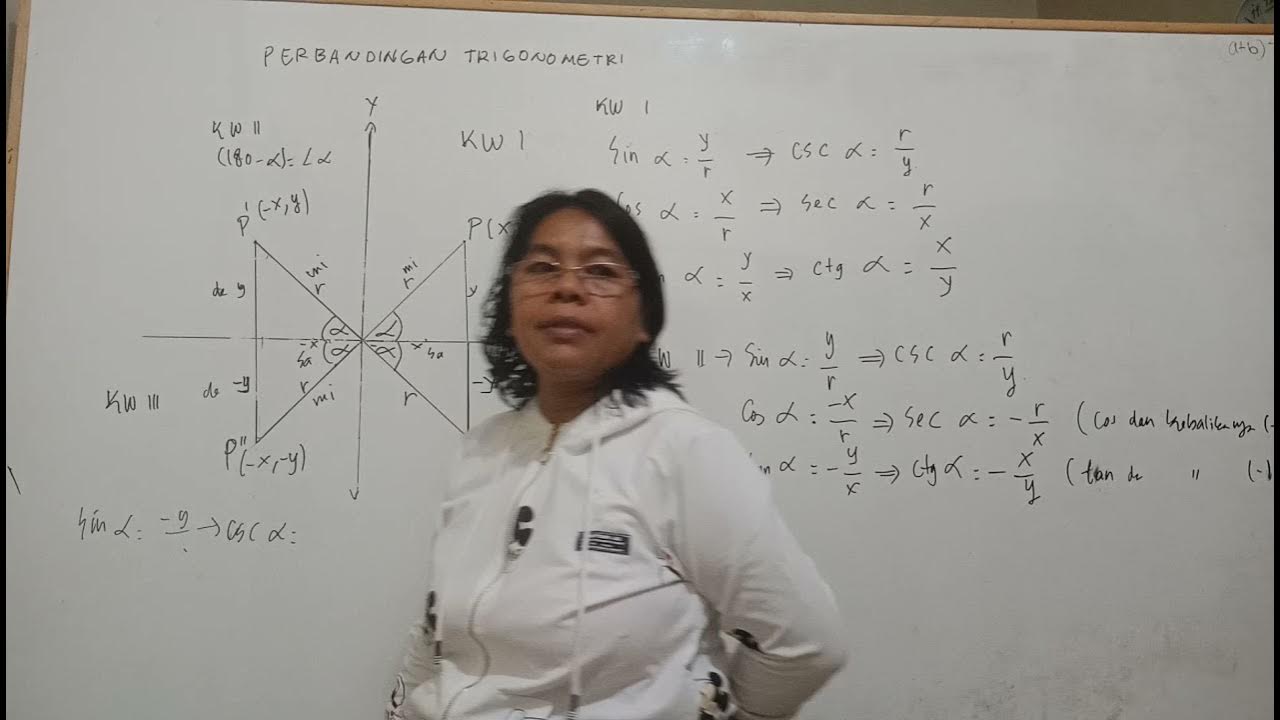Limits of Trigonometric Functions
Summary
TLDRThis video covers examples of evaluating limits involving trigonometric functions. It explains the limit of sin(x)/x as x approaches 0, confirming that it equals 1, and also examines the limit of (1 - cos(x))/x, which equals 0. The video provides step-by-step solutions for problems involving limits like sin(5x)/x, sin(2x)/5x, and tan(4x)/3x, showing methods of substitution and simplification. It also discusses more complex cases involving expressions with sine squared and tangent functions. Through these examples, viewers gain a deeper understanding of limits with trigonometric functions.
Takeaways
- 📉 The limit as x approaches 0 of sin(x)/x equals 1, and this can be verified by plugging in values close to 0.
- 🔢 The limit as x approaches 0 of (1 - cos(x))/x equals 0, and smaller values of x will yield closer results to zero.
- ✍️ To solve the limit of sin(5x)/x as x approaches 0, you multiply the numerator and denominator by 5 and use substitution (y = 5x).
- 🧠 The limit of sin(2x)/(5x) as x approaches 0 equals 2/5, which can be quickly seen or solved through substitution.
- ➗ The limit of sin(7x)/sin(3x) as x approaches 0 equals 7/3, which can be derived by multiplying and substituting.
- ☑️ The limit of tan(x)/x as x approaches 0 equals 1, which can be simplified using trigonometric identities.
- 💡 The limit of tan(4x)/(3x) as x approaches 0 equals 4/3 by converting tan(x) into sin(x)/cos(x) and using substitution.
- 🧮 The limit of 7 * (1 - cos(x))/x as x approaches 0 equals 0 since the (1 - cos(x))/x term approaches 0.
- 📝 For the limit of sin^2(x)/x as x approaches 0, the answer is 0 since sin(x)/x approaches 1 but multiplying by 0 results in 0.
- 📊 The limit of sin(x^2)/x as x approaches 0 is also 0, which can be solved by substitution and splitting the expression into separate limits.
Q & A
What is the limit as x approaches 0 of sin(x)/x?
-The limit as x approaches 0 of sin(x)/x is 1. This can be confirmed by evaluating values close to 0, such as sin(0.1)/0.1, which is approximately 0.998, and sin(0.01)/0.01, which is approximately 0.99998.
What is the limit as x approaches 0 of (1 - cos(x))/x?
-The limit as x approaches 0 of (1 - cos(x))/x is 0. As you substitute values closer to 0, the result gets closer to 0, such as (1 - cos(0.1))/0.1 ≈ 0.05 and (1 - cos(0.01))/0.01 ≈ 0.005.
How can you solve the limit as x approaches 0 of sin(5x)/x?
-To solve this limit, multiply both the numerator and denominator by 5, transforming the expression into (sin(5x)/(5x)) * 5. Substituting y = 5x, this becomes sin(y)/y * 5, where the limit as y approaches 0 of sin(y)/y is 1. Thus, the result is 5.
What is the limit as x approaches 0 of sin(2x)/(5x)?
-The limit is 2/5. By multiplying both the numerator and denominator by 2/2 and substituting y = 2x, the expression becomes (sin(y)/y) * (2/5), and the limit as y approaches 0 of sin(y)/y is 1. Thus, the result is 2/5.
What is the limit as x approaches 0 of sin(7x)/sin(3x)?
-The limit is 7/3. By multiplying the numerator and denominator by the necessary constants, the expression simplifies to (sin(7x)/(7x)) * (3x/sin(3x)) * (7/3), and using known limits of sin(y)/y, the result is 7/3.
How do you evaluate the limit as x approaches 0 of tan(x)/x?
-Rewrite tan(x) as sin(x)/cos(x), so the expression becomes (sin(x)/x) * (1/cos(x)). The limit of sin(x)/x as x approaches 0 is 1, and cos(0) = 1, so the result is 1.
What is the limit as x approaches 0 of tan(4x)/(3x)?
-The limit is 4/3. By expressing tan(4x) as sin(4x)/cos(4x) and multiplying by 4/4, the expression simplifies to (sin(4x)/(4x)) * (4/3), and using the limit sin(y)/y as 1, the result is 4/3.
What is the limit as x approaches 0 of 7 * (1 - cos(x))/x?
-The limit is 0. Since the limit as x approaches 0 of (1 - cos(x))/x is 0, multiplying by 7 results in 7 * 0 = 0.
How do you solve the limit as x approaches 0 of sin²(x)/x?
-Rewrite sin²(x) as sin(x) * sin(x), then the expression becomes (sin(x)/x) * sin(x). As x approaches 0, sin(x)/x approaches 1, and sin(0) is 0, so the result is 1 * 0 = 0.
What is the limit as x approaches 0 of sin(x²)/x?
-First, multiply both the numerator and denominator by x, giving (sin(x²)/(x²)) * x. Substituting y = x², the expression becomes sin(y)/y * x, where the limit of sin(y)/y is 1, and x approaches 0, so the result is 0.
Outlines

This section is available to paid users only. Please upgrade to access this part.
Upgrade NowMindmap

This section is available to paid users only. Please upgrade to access this part.
Upgrade NowKeywords

This section is available to paid users only. Please upgrade to access this part.
Upgrade NowHighlights

This section is available to paid users only. Please upgrade to access this part.
Upgrade NowTranscripts

This section is available to paid users only. Please upgrade to access this part.
Upgrade NowBrowse More Related Video

1.4 Limit Fungsi Trigonometri

✅INTEGRALES trigonométricas con POTENCIAS [𝙚𝙣 4 𝙋𝙖𝙨𝙤𝙨 😎🫵💯 ] Cálculo Integral

Perbandingan Trigonometri

Section 6.2 - Trig integrals and substitution - Part 1

ECUACIONES TRIGONOMETRICAS

Limit Fungsi Trigonometri Matematika Kelas 12 • Part 1: Konsep dan Penurunan / Pembuktian Rumus
5.0 / 5 (0 votes)